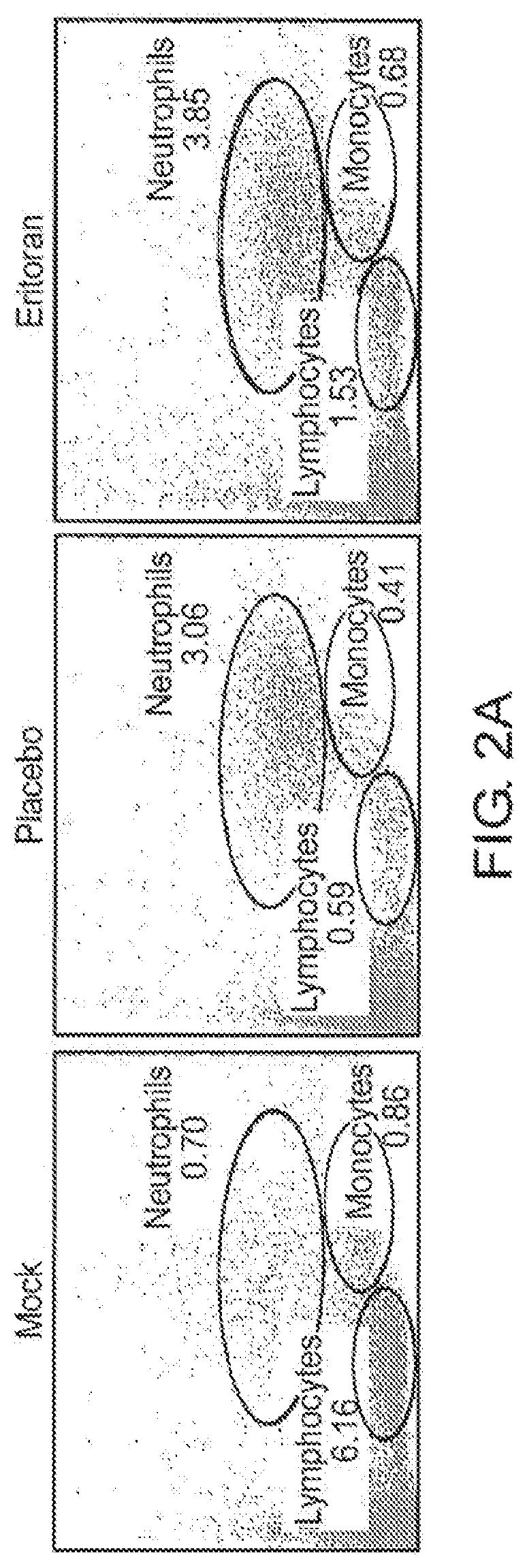Method of use of eritoran as a TLR4 antagonist for treatment of ebola and Marburg disease
a technology which is applied in the field of ebola and marburg virus treatment, can solve the problems of unproven evd treatment, no licensed vaccine is available for evd treatment, and the implications of tlr4 signaling in the pathogenesis of evd have so far remained highly circumstantial, so as to reduce marburg-induced cytokine levels, reduce marburg-induced chemokine levels, and reduce marburg-induced
- Summary
- Abstract
- Description
- Claims
- Application Information
AI Technical Summary
Benefits of technology
Problems solved by technology
Method used
Image
Examples
example 1
Animal Challenge and Treatment
[0066]All work with EBOV was performed in BSL-4 facilities of the Galveston National Laboratory. Flow cytometry was performed following inactivation with 4% paraformaldehyde in PBS for 48 hours according to the University of Texas Medical Branch standard operating procedure and removed from BSL-4 for analysis with LSRII Fortessa flow cytometer (BD Biosciences) available at the University of Texas Medical Branch Flow Cytometry Core Facility. To remove serum samples from EBOV-infected mice, samples were gamma-irradiated with the 5 Mrad dose according the University of Texas Medical Branch standard operating procedure protocol. The staff had the U.S. government permissions and appropriate training for work with EBOV.
[0067]EBOV infection of mice was performed in the ABSL-4-containment facilities at the Galveston National Laboratories in accordance with the University of Texas Medical Branch Institutional Animal Care and Use Committee. Wildtype C57BL / 6J mice...
example 2
[0072]C57BL / 6J mice between the ages of 7-8 weeks were infected with 1000 pfu mouse adapted EBOV via intraperitoneal injection at Day 0, which routinely results in 100% rates of death within 7 days of challenge. Mice then received ten consecutive daily doses consisting of intraperitoneal injections administering 233 μg eritoran (E5564) or vehicle starting at Day 0. Each mouse was weighed and clinically scored daily for symptoms associated with disease progression. Once signs of disease progression were observed, mice were monitored twice daily. Mice receiving a score a total score of 8, or 3 in any individual category, were promptly euthanized per institutional protocol. 100% of mice receiving the placebo died or met criteria for euthanization by day 7 following challenge (FIG. 1B). Of the mice receiving daily eritoran treatment, 70% survived until the end of the study, 28 days post-challenge (p− / − mice would survive lethal EBOV-challenge. However, TLR4− / − mice remained as susceptib...
example 3
[0080]As filoviruses, a collective family of related viruses, share common features associated with bacterial sepsis, the ability of eritoran to protect mice from lethal MARV challenge was assessed. Mice were treated as indicated in the outline provided in FIG. 1A; however, mice were challenged with mouse adapted MARV at day 0. As indicated in FIG. 10A, 90% of infected mice survived lethal MARV challenge, whereas one mouse (20%) from the control group survived. The average clinical score for eritoran treated mice remained relatively unchanged as only the mouse that succumbed to infection received a score greater than 1 (FIG. 10B). Conversely, all mice in the control group received clinical scores of 3 or 4 at days 8 and 9 post-challenge. As observed in EBOV-infected mice, the average weight of control mice decreased considerably following MARV challenge (FIG. 10C); however, only a minimal reduction was observed in eritoran treated mice. Similar to the weight gains observed in EBOV-i...
PUM
 Login to View More
Login to View More Abstract
Description
Claims
Application Information
 Login to View More
Login to View More - R&D
- Intellectual Property
- Life Sciences
- Materials
- Tech Scout
- Unparalleled Data Quality
- Higher Quality Content
- 60% Fewer Hallucinations
Browse by: Latest US Patents, China's latest patents, Technical Efficacy Thesaurus, Application Domain, Technology Topic, Popular Technical Reports.
© 2025 PatSnap. All rights reserved.Legal|Privacy policy|Modern Slavery Act Transparency Statement|Sitemap|About US| Contact US: help@patsnap.com



